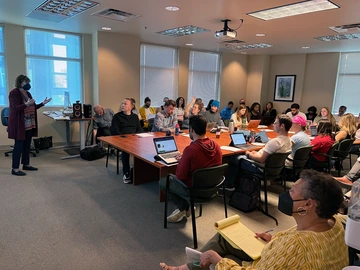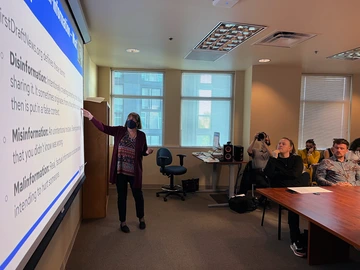International Journalists visit Professor Susan Swanberg's class
International visitors from the Edward R. Murrow Program for Journalists joined Swanberg's environmental journalism students for a training on the spread of disinformation.

On Monday, Nov. 7, Professor Susan Swanberg welcomed a group of international journalists from the Edward R. Murrow Program for Journalists to her Environmental Journalism class for a spirited discussion on the spread of disinformation.
"The presence of professional journalists from around the globe enhanced the class discussion concerning a problem journalists everywhere face - how to deal with misinformation and disinformation," Swanberg said.
Swanberg led the class through a presentation created by the Radio Television Digital News Association (RTDAA) on ethical guidelines for journalists to stop the spread of misinformation and disinformation.
First Draft News, a nonprofit organization that invented new methods and resources for mitigating misinformation and now functions out of the Brown School of Public Health Information Futures Lab, defines the terms of misinformation, disinformation, and malinformation:
- Disinformation: Intentionally creating something that is false and sharing it. It sometimes originates from a true photo or quote, and then is put in a false context.
- Misinformation: An unintentional mistake. Sharing something that you didn’t know was wrong.
- Malinformation: Real, factual information or pictures shared intending to hurt someone.

All of these are important concepts for budding journalism students. The rise of disinformation became more concerning to journalists during the COVID-19 pandemic in 2019, as mentioned by Swanberg’s student Lisitte Mora.
“If you take COVID for example, people were getting frustrated with new information like ‘new information came out last week I’m confused, they are lying.’ When really, we had more information because more research was being done so I think it’s important as journalists to explain that this is an ongoing story to help the public understand,” Mora said.
Swanberg agreed, telling the class that science changes and evolves over time. Science journalists are at the forefront of stopping the spread of science misinformation because they communicate new science to the public. Swanberg’s science journalism courses train students how to spot questionable science and how to accurately communicate scientific research to audiences. Interested students can take JOUR 465/565 (Issues in Covering Science and the Environment) with Professor Swanberg for Spring 2023.
Students from across campus can also take GLO 460/560 (Disinformation & Information Security in a Global Media Context) in Spring 2023.
“In this course, students use the latest tools for verifying and authenticating digital information, including images, audio and video, and they work on real world social issues generated from mis-or-disinformation,” Professor Jeannine Relly said. Relly is the director of the Center for Border and Global Journalism and the director of the Studies of Global Media Programs.
“They each work on a project that includes studying the seeding of disinformation in a manipulation campaign,” Relly said. “They are asked to vet information from the campaign and find ways, if any, in which the issue has been addressed.”

Relly said the course was so well-received that Studies of Global Media created a new course that “focuses specifically on science and misinformation, disinformation, media and the public in the coming academic year, which Dr. Susan Swanberg, an expert in this area, will be designing.” The course is GLO 465/565 (Science Misinformation, Disinformation, Media & the Public).
Contact our Undergraduate Academic Advisor Paloma Boykin at boykin1@arizona.edu for more information about these courses.
You can find the publicly available RTDNA training by clicking here.
Many thanks to our international visitors from the Edward R. Murrow Program for Journalists:
·From Albania, Ilda LONDO
Research and Project Coordinator, Albanian Media Institute
·From Belgium, Jago KOSOLOSKY
Editor-in-Chief, MO* Magazine (global affairs quarterly)
·From Bulgaria, Mariya Teodorova CHERESHEVA
Vice President and Project Manager, Association of European Journalists-Bulgaria (AEJ-Bulgaria)
·From Bulgaria, Ms. Rumena Valentinova FILIPOVA, Ph.D.
Chairperson and Co-Founder, Institute for Global Analytics
·From Finland, Mr. Mikko Valtteri SALO
Senior Advisor, Lappeenranta-Lahti University of Technology (LUT); Co-Founder, Faktabaari and NewsBeez
·From France, Mr. Gregoire Ferreol Andre LEMARCHAND
Deputy Editor-in-Chief and Head of Social Networks and Fact-Checking, Agence France-Presse (AFP)
·From France, Mr. Eric Maxime NAHON
Deputy Director, Department of Journalism, IPJ (Institut Pratique du Journalisme) Dauphine / PSL (Paris Sciences et Lettres) University
·From Greece, Mr. Dimitrios BOUNIAS
Project Manager, iMEdD (Incubator for Media Education and Development)
·From the Republic of Kosovo, Mr. Alban ZENELI, Ph.D.
Assistant Professor, Department of Journalism, University of Prishtina
·From Montenegro, Ms. Slavica JOVANOVIC
Co-Owner, Jumedia Mont
·From Poland, Mr. Marcin MAKOWSKI
Journalist, Interia.pl Web Portal
·From the Republic of North Macedonia, Ms. Sashka CVETKOVSKA
Editor-in-Chief and Co-Founder, Investigative Reporting Lab
Center Director, Organized Crime and Corruption Reporting Project (OCCRP)
·From the Republic of North Macedonia, Mr. Zharko DIMITRIOSKI
Creative Director and Managing Partner, BDG Marketing Agency
·From Spain, Ms. Nereida CARRILLO PEREZ, Ph.D.
Freelance Journalist and Founder of Learn To Check; Associate Professor of Journalism, Autonomous University of Barcelona (UAB)
·From Switzerland, Ms. Bettina MUELLER MOLO
Head of World News Radio, RSI
·From Turkey, Ms. Oyku GOGER
Radio Host, Radyo ODTU
·From the United Kingdom, Ms. Sana SAFI
Senior Presenter, Pashto TV, BBC
·From the United Kingdom, Ms. Rachel Jane Norma WATSON
Deputy Political Editor, Scottish Daily Mail

